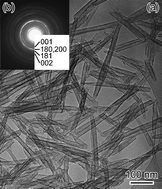Highly crystalline niobium oxide converted from flux-grown K4Nb6O17 crystals
Abstract
Highly crystalline niobium oxide (Nb2O5)

* Corresponding authors
a
Department of Environmental Science and Technology, Faculty of Engineering, Shinshu University, Nagano, Japan
E-mail:
teshima@gipwc.shinshu-u.ac.jp
b
Institute for Materials Research, Tohoku University, Sendai, Japan
E-mail:
yubuta@imr.tohoku.ac.jp
c
Institute of Carbon Science and Technology, Shinshu University, Nagano, Japan
E-mail:
oishish@gipwc.shinshu-u.ac.jp
d
Department of Electrical and Electronic Engineering, Faculty of Engineering, Shinshu University, Nagano, Japan
E-mail:
endo@endomoribu.shinshu-u.ac.jp
Highly crystalline niobium oxide (Nb2O5)

 Please wait while we load your content...
Something went wrong. Try again?
Please wait while we load your content...
Something went wrong. Try again?
S. Lee, K. Teshima, Y. Niina, S. Suzuki, K. Yubuta, T. Shishido, M. Endo and S. Oishi, CrystEngComm, 2009, 11, 2326 DOI: 10.1039/B905870B
To request permission to reproduce material from this article, please go to the Copyright Clearance Center request page.
If you are an author contributing to an RSC publication, you do not need to request permission provided correct acknowledgement is given.
If you are the author of this article, you do not need to request permission to reproduce figures and diagrams provided correct acknowledgement is given. If you want to reproduce the whole article in a third-party publication (excluding your thesis/dissertation for which permission is not required) please go to the Copyright Clearance Center request page.
Read more about how to correctly acknowledge RSC content.
 Fetching data from CrossRef.
Fetching data from CrossRef.
This may take some time to load.
Loading related content
